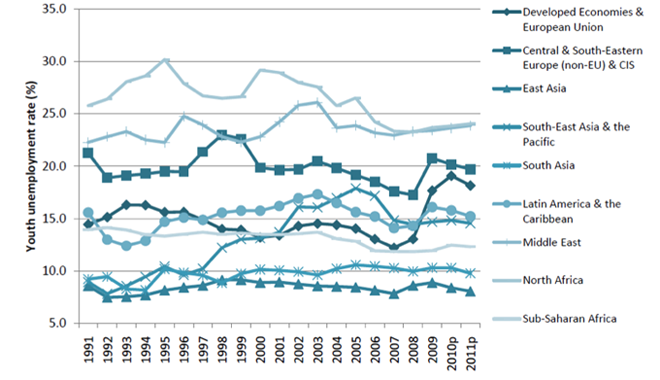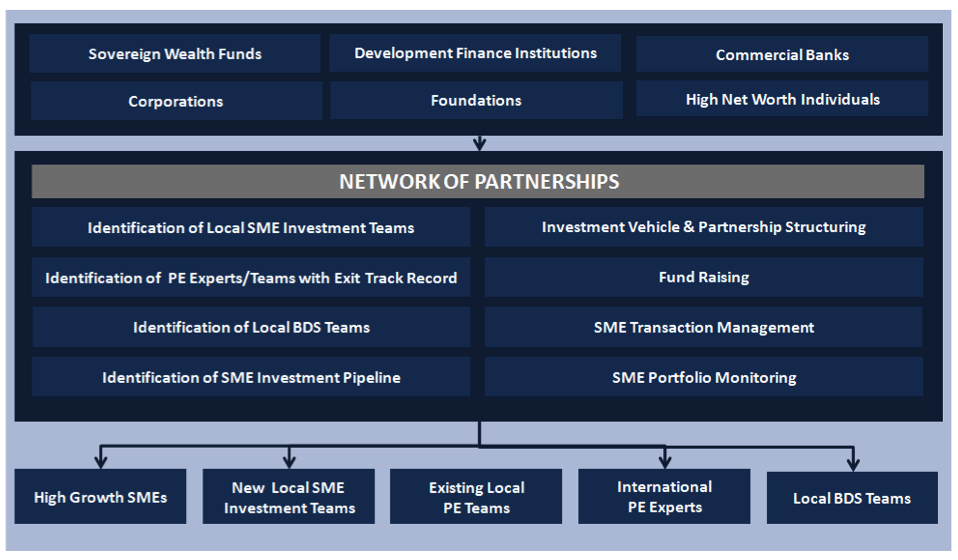Build Local SME Investment Vehicles to create Sustainable Youth Employment in the MENA region, Sub-Saharan Africa or Asia
Youth Unemployment Rate Worldwide: 1991 – 2011.

Source: International Labor Office.
- The SME Opportunity in MENA
- Small Number of SMEs. In Many MENA countries, the SME sector is insufficiently developed. Algeria, for instance, has about 400 000 SMEs, when it labor force could justify 1.3 million.
- Lack of high impact SMEs. Most jobs are expected to be created by a minority of high growth firms (such innovative firms account for less than 10% of firms but create more than 50% of new jobs every year). Yet, for various reasons, the MENA region does not have enough SMEs, and particularly lack high growth SMEs who could create many jobs for the Arab youth.
- Lack of financing & expertise. According to the World Bank, SMEs from the MENA region are among the least financed in the world and lack the necessary management expertise to grow. The region does not yet have the right infrastructure to provide both the financing and expertise to SMEs. There are very few SME investment vehicles with the right expertise and focus, particularly for start ups, small enterprises, and women owned/managed SMEs.
- Time pressure. Until very recently, the MENA region did not fully recognize the economic and social implications of its demographic transition. We need to build this infrastructure in the next 10 to 15 years, much faster than the 30 to 40 years it took in the US or Europe.
- The Missing Middle. Across the MENA region, SMEs account for 2/3 of jobs and are crucial drivers of economic development. Every $1 invested in an SME generates an additional $10 in the local community and $1 of SME finance creates 3 times more jobs than an equivalent investment in microfinance. Yet, for various reasons that we could correct less than 20% of SMEs have access to financing. This lack of financing and management support is particularly strong on the “S” segment of SMEs, where investments are between $100 000 and $2m. Closing this “Equity gap” requires an innovative approach that is necessary to accelerate the growth of the SME ecosystem. Transactions between $2m and $10m are better covered, more profitable, but still largely underdeveloped.
- What We Do: We need a scalable solution that will increase the size of the region’s SME pipeline and support its high growth SMEs. The scale of the task and time pressure mean that we need to build various local partnerships across the region, combine them with a regional team of highly experienced SME investment professionals. They will transfer their skills to the local teams, build a deal pipeline, then raise regional and local funds with various partners.
Armalia Partners would structure this initiative and become an integral member of the SME investment team, building its investment process, execute transactions, monitor investments. The same approach could be applied in Africa and Asia.
According to the International Labor Office, the Arab World already has the highest youth unemployment rate in the world and will need to create an additional 74 million jobs in the next 15 years to absorb new entrants to its job market. This is equivalent to a 75% increase in its workforce, or equal to the total growth of its workforce between 1950 and 2000. Most of these new jobs are expected to be created by Small and Medium Sized Enterprises.

